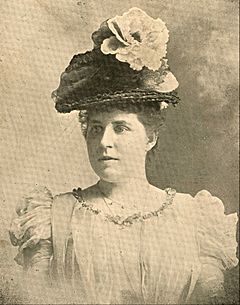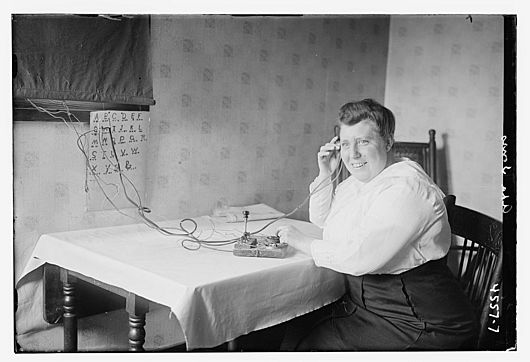Ada Jones facts for kids
Quick facts for kids
Ada Jones
|
|
|---|---|
 |
|
| Background information | |
| Birth name | Ada Jane Jones |
| Born | June 1, 1873 Lancashire, England, UK |
| Died | May 22, 1922 (aged 48) Rocky Mount, North Carolina |
| Genres | Vocal, ragtime, vaudeville, comedy |
| Occupation(s) | Singer |
| Years active | 1889–1922 |
| Labels | North American Phonograph Company, Edison |
| Associated acts | American Quartet, Billy Murray, Len Spencer, Cal Stewart |
Ada Jane Jones (born June 1, 1873 – died May 22, 1922) was a popular singer from England and America. She was one of the very first female singers to have her voice recorded. Her first recordings were made in 1893 on special wax cylinders.
About Ada Jones
Ada Jones was born in Lancashire, England. When she was six years old, in 1879, her family moved to Philadelphia, Pennsylvania in the United States. She started performing on stage when she was still a child in the 1880s.
Ada had a deep singing voice, called a contralto. She learned songs by listening to them, as she couldn't read music or play any instruments. She sang many different types of songs. These included ballads (storytelling songs), ragtime (a lively, syncopated music style), vaudeville (a type of stage entertainment), and funny songs. She could also sing in different accents.
Between 1893 and 1894, Ada recorded for Edison Records. She used wax cylinders to record her voice. This made her one of the earliest women singers ever to be recorded. She sang with other famous artists like Billy Murray, Cal Stewart, and the American Quartet. She even sang with her own daughter, Sheilah, who was 12 years old. Ada faced challenges with her health, which made touring difficult for her.
In 1893 or 1894, she recorded songs like "Sweet Marie" and "The Volunteer Organist" for the North American Phonograph Company. But this company closed down, which stopped her recording career for a while. She didn't start recording again until 1905. Before that, she performed live in places like Huber's 14th Street Museum in New York City.
In 1909, Ada Jones recorded her most famous song, "The Yama Yama Man", for the Victor Light Opera Company. This song was a huge hit! It stayed at number one on the charts for five weeks.
Ada Jones passed away in Rocky Mount, North Carolina, on May 22, 1922. She died from kidney failure.
Popular Songs by Ada
Here are some of the songs Ada Jones recorded:
- "Sweet Marie" (around 1893–94)
- "The Volunteer Organist" (around 1893–94)
- "Please Come Play in My Yard" (1905)
- "I'm a Woman of Importance" (1906)
- "Don't Get Married Any More, Ma" (1906, 1907; recorded multiple times)
- "Experience (from 'The Little Cherub')" (1906)
- "Peaches and Cream", with Len Spencer (1906)
- "All She Gets from the Iceman Is Ice" (1907)
- "If the Man in the Moon Were a Coon" (1907)
- "I Just Can't Make My Eyes Behave" (1907)
- "Now I Have to Call Him 'Father'" (1908)
- "I've Got Rings On My Fingers" (1909)
- "My Pony Boy" (1909)
- "The Yama Yama Man" (1909)
- "Call Me Up Some Rainy Afternoon" (1910)
- "Oh, You Candy Kid" (1910)
- "The Girl With the Brogue" (1910)
- "Whistle It" (1912) (with Peerless Quartet)
- "Row! Row! Row!" (1913)
- "Beatrice Fairfax, Tell Me What to Do!" (1915)
Songs with Billy Murray
Ada Jones also recorded many popular songs with fellow singer Billy Murray:
- "Under the Anheuser Bush" (Promotional song)
- "Let's Take an Old-Fashioned Walk" (1907)
- "School Days" (1907)
- "Cuddle up a Little Closer, Lovey Mine" (1908)
- "The Boy Who Stuttered and the Girl Who Lisped" (1908)
- "Wouldn't You Like to Have Me for a Sweetheart?" (1908)
- "Blue Feather" (1909)
- "Can't You See I Love You" (1909)
- "Googy-oo" (1909)
- "I Can't Say You're the Only One" (1909)
- "Oh You Kid!" (1909)
- "Shine On, Harvest Moon" (1909)
- "Rainbow" (1909)
- "Come Josephine in My Flying Machine" (1911)
- "My Hula Hula Love" (1911)
- "Be My Little Baby Bumble Bee" (1912)
- "Nora Malone (Call Me by Phone)" (1912)
- "Silver Bell" (1912)
- "If I Said 'Please'" (1913)
- "Snow Deer" (1913)
- "Somebody's Coming to My House" (1913)
- "Bedtime at the Zoo" (1914)
- "By the Beautiful Sea" (1914)
- "Dixie" (1916)
- "What Do You Want to Make Those Eyes at Me For?" (1917)
- "Some Sunday Morning" (1918)


